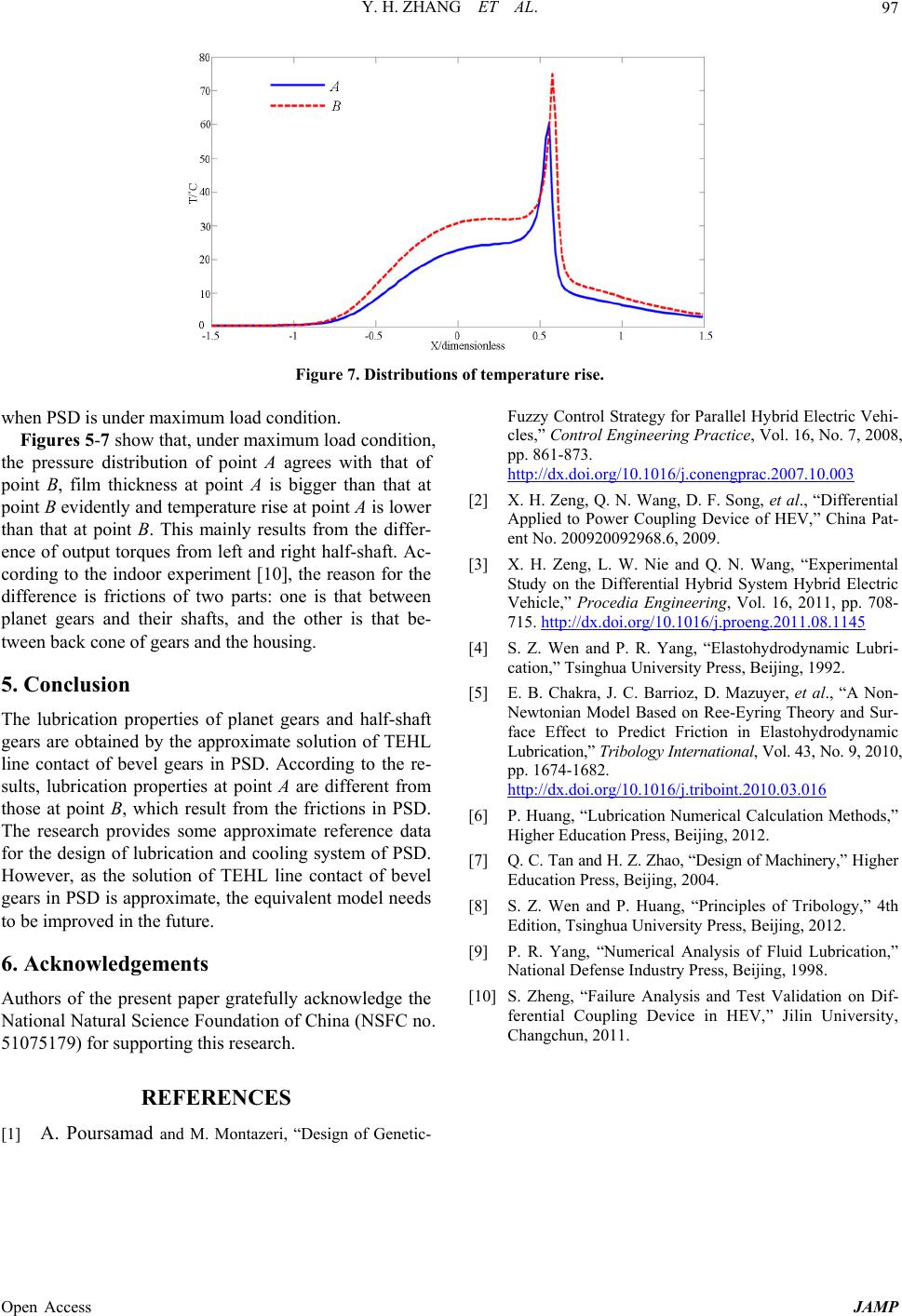
Y. H. ZHANG ET AL. 97
Figure 7. Distributions of temperature rise.
when PSD is under maximum load condition.
Figures 5-7 show that, under maximum load condition,
the pressure distribution of point A agrees with that of
point B, film thickness at point A is bigger than that at
point B evidently and temperature rise at point A is lower
than that at point B. This mainly results from the differ-
ence of output torques from left and right half-shaft. Ac-
cording to the indoor experiment [10], the reason for the
difference is frictions of two parts: one is that between
planet gears and their shafts, and the other is that be-
tween back cone of gears and the housing.
5. Conclusion
The lubrication properties of planet gears and half-shaft
gears are obtained by the approximate solution of TEHL
line contact of bevel gears in PSD. According to the re-
sults, lubrication properties at point A are different from
those at point B, which result from the frictions in PSD.
The research provides some approximate reference data
for the design of lubrication and cooling system of PSD.
However, as the solution of TEHL line contact of bevel
gears in PSD is approximate, the equivalent model needs
to be improved in the future.
6. Acknowledgements
Authors of the present paper gratefully acknowledge the
National Natural Science Foundation of China (NSFC no.
51075179) for supporting this research.
REFERENCES
[1] A. Poursamad and M. Montazeri, “Design of Genetic-
Fuzzy Control Strategy for Parallel Hybrid Electric Vehi-
cles,” Control Engineering Practice, Vol. 16, No. 7, 2008,
pp. 861-873.
http://dx.doi.org/10.1016/j.conengprac.2007.10.003
[2] X. H. Zeng, Q. N. Wang, D. F. Song, et al., “Differential
Applied to Power Coupling Device of HEV,” China Pat-
ent No. 200920092968.6, 2009.
[3] X. H. Zeng, L. W. Nie and Q. N. Wang, “Experimental
Study on the Differential Hybrid System Hybrid Electric
Vehicle,” Procedia Engineering, Vol. 16, 2011, pp. 708-
715. http://dx.doi.org/10.1016/j.proeng.2011.08.1145
[4] S. Z. Wen and P. R. Yang, “Elastohydrodynamic Lubri-
cation,” Tsinghua University Press, Beijing, 1992.
[5] E. B. Chakra, J. C. Barrioz, D. Mazuyer, et al., “A Non-
Newtonian Model Based on Ree-Eyring Theory and Sur-
face Effect to Predict Friction in Elastohydrodynamic
Lubrication,” Tri bology I nternational, Vol. 43, No. 9, 2010,
pp. 1674-1682.
http://dx.doi.org/10.1016/j.triboint.2010.03.016
[6] P. Huang, “Lubrication Numerical Calculation Methods,”
Higher Education Press, Beijing, 2012.
[7] Q. C. Tan and H. Z. Zhao, “Design of Machinery,” Higher
Education Press, Beijing, 2004.
[8] S. Z. Wen and P. Huang, “Principles of Tribology,” 4th
Edition, Tsinghua University Press, Beijing, 2012.
[9] P. R. Yang, “Numerical Analysis of Fluid Lubrication,”
National Defense Industry Press, Beijing, 1998.
[10] S. Zheng, “Failure Analysis and Test Validation on Dif-
ferential Coupling Device in HEV,” Jilin University,
Changchun, 2011.
Open Access JAMP